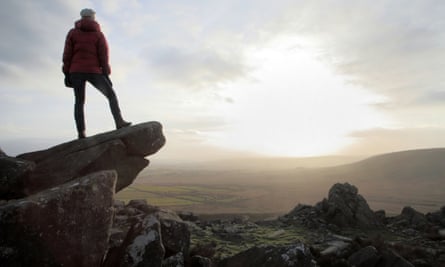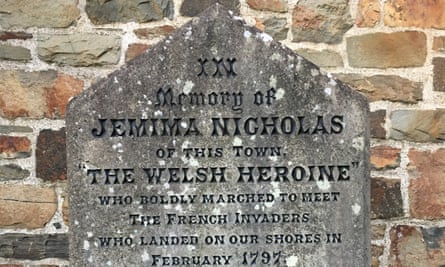On a lonely road near the village of Eglwyswrw in Pembrokeshire, I pull over as instructed and check my position. I can see the crags up on the ridge to my left, and I can see the boggy ground between. This must be the spot. I set off on foot up the squelchy, tussocky slope, picking a circuitous path towards the ridge and those distinctive crags, part of the Preseli hills.
The Guardian’s product and service reviews are independent and are in no way influenced by any advertiser or commercial initiative. We will earn a commission from the retailer if you buy something through an affiliate link. Learn more.
The Welsh tourist board has dubbed 2017 a Year of Legends to celebrate the land’s epic past, with events and new routes encouraging visitors to explore. Pembrokeshire is particularly rich in history and I’m trying out part of the recently unveiled 118-mile Legends Cycle Route, as well as the pick-and-mix Legends Tombstone Trail, which covers all of south-west Wales (both can be done by either bike or car).
The place is thick with antiquity: forts, settlements, burial chambers and cairns, plus innumerable references to King Arthur. Little wonder JRR Tolkein loved the area. Every hollow and hillock seems imbued with deep significance and dark secrets. The Legends route starts in Neath, the other side of Swansea, but I’m covering the last 25 miles of it before picking up the Pembrokeshire section of the Tombstone Trail, finishing almost as far west as you can go, in St Davids.
The Preseli hills are not high – just 536 metres at their highest point – but they make up for lack of stature in austere drama. I get my first taste of this from the top, looking west across a landscape of bogs, crags and treeless slopes. This ridge line is reputedly the ancient Golden Road along which gold mined in Ireland’s Wicklow hills was transported to southern England. I climb to the highest set of boulders, marvelling at their boxy geometry. Am I imagining that slight bluish tint to their smooth flat surfaces? Is there something unusual in this rock formation? Like it was manmade long ago? A tremor of excitement hits me.

My journey into the myths and legends of north Pembrokeshire started just the day before, and with a spot of good luck. A glamping site on a farm called Ffynnon Samson, just south of the Preseli hills, proves to be a charming place with a campfire and great views of the Milky Way, and its welcoming owners, Emily and Matt Marl, turn out to be inspirational travel gurus for the region.
Taking me on a tour of the farm, Emily has a flood of useful tips – places to walk, swim, eat and drink – and some unexpected gems: “There’s a ring of standing stones at Gors Fawr [a few miles to the north-east]. If you jump up and down three times in the exact centre, you’ll drop through a portal into another world.” And more practically: “The pub in Rosebush is excellent, and Welsh-speaking. When Matt was learning, he tried to order in Welsh and got “ice” mixed up with “sex” – rhew and rhyw. It does make a difference.”

While I’m trying to imagine Matt demanding, “a Coke with plenty of sex”, Emily is on to the next thing: “Don’t miss Pentre Ifan burial chamber – wonderful at sunset.”
My notebook is brimming with ideas for side trips off my main route when Emily delivers her killer line: “You know they mined the Stonehenge bluestones just up the road?”
That was the one that got me. That would be my starting point. That was how I ended up climbing Three Cairns hill to Foel Drygarn fort and taking the Golden Road, wondering how on earth those massive stones could have been transported 150 miles to Wiltshire. It is still a total mystery. For me the other big mystery is why this lonely Welsh mountain has more soul than Stonehenge. One reason may be that much of Wales has maintained a deep connection of language and landscape, an unbroken centuries-old relationship. And with that connection, the legends linger.

Next day I explore Fishguard, finishing point of the Legends Trail and where I pick up the Tombstone. I start with the grave of Jemima Nicholas, a formidable local cobbler who in 1797 managed to take a dozen French soldiers prisoner armed only with a pitchfork. This rather bizarre event, part of the last invasion of Britain by a foreign power, is recalled in a wonderful 30-metre-long tapestry in the Town Hall. Jemima’s grave is in the churchyard over the road, conveniently close to the Royal Oak pub, where Lord Cawdor, commander of the British forces, had his HQ at the time. It’s a handy spot in which to ponder the strange tale, as is the high street’s Transition Café, a warm-hearted community venture dedicated to sustainable food.
From Fishguard I drive to nearby Strumble Head, then walk south on a spectacular stretch of coastal path to an atmospheric ancient fort just above Pwll Deri YHA (surely the most spectacularly sited youth hostel in the UK). A short hop south-west in the car brings me to Abercastle, where another coastal walk brings me to Carreg Samson, a neolithic burial chamber.

There are so many monuments in north Pembrokeshire, you can pick and choose what suits your interests. One I didn’t want to miss is the simple marker stone inland at Little Newcastle, birthplace of Bartholomew Roberts, one of the most successful pirates of all time – until the Royal Navy gunned him down in 1722.
Nearby, taking Emily’s tip, I visit Rosebush’s pub, Tafarn Sinc, which has everything you’d want: home cooking, real ale, sawdust on the floor and lots of history. It is here, finally, among the Welsh speakers at the bar, that I get to discover what had bothered me from the start of the journey: how to pronounce Eglwyswrw (egglissooroo, roughly). And I get ice in my drink.
Having switched my own HQ to a smart little cottage further west, I reach my finishing line at St Davids, where the cathedral is worth visiting, especially if you like knights – there’s a few in there, lying in state and stone, all awaiting Arthur’s call. In this part of the world, the legends never die.
Way to go
The trip was provided by Visit Pembrokeshire. For details of the trails see southwest.wales/legends. Ffynnon Samson (canopyandstars.co.uk), a converted truck in a patch of woodland, costs from £75 a night for two. Ty Lloi (ownersdirect.co.uk/accommodation/p6555275), a barn conversion for two near Haverfordwest, costs from £350 a week









Comments (…)
Sign in or create your Guardian account to join the discussion